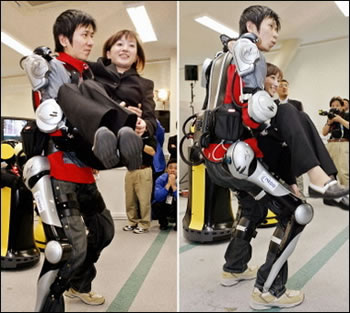
The fifteen kilogram battery-powered suit detects muscle movements through electrical signal flows on the skin surface. These currents are picked up by the sensors and sent to the computer, which translates the nerve signals into signals of its own for controlling electric motors at the hips and knees of the exoskeleton, effectively amplifying muscle strength. HAL stands for "hybrid assistive limb"; HAL-5 is the latest version of the suit.
HAL-5 (Hybrid Assistive Leg), the robotic exoskeleton developed to help humans lift and carry a greater load, will now help cary a Japanese quadtiplegic to the top of a moutain.
| "We developed the exo-skeleton type power assist system to realize the walking aid for the gait disorder person. At the present time, HAL is state of the art power assist system in the world. Some sensors such as angle sensors, myoelectrical sensors, floor sensors etc. are adopted in order to obtain the condition of the HAL and the operator. All of the motordrivers, measurement system, computer, wireless LAN, and power supply are built in the backpack. Using the battery attached on the waist, HAL works as the complete wearable system." Prof. Sankai, Univ. of Tsukuba / CYBERDYNE Inc |
(HAL-5 endoskeleton system)
HAL provides enough additional strength to lift an additional eighty kilograms of weight. The trek is planned for this summer.
Robotic exoskeletons have played a part in science fiction stories for decades. In his 1968 novel A Specter is Haunting Texas, science fiction writer Fritz Leiber describes specialized exoskeletons used to help human beings who grew up under microgravity conditions survive on the Earth's surface:
This truly magnificient, romantically handsome, rather lean man was standing on two corrugated-soled titanium footplates. From the outer edge of each rose a narrow titanium T-beam that followed the line of his leg, with a joint (locked now) at the knee, up to another joint with a titanium pelvic girdle and shallow belly support. From the back of this girdle a T-spine rose to support a shoulder yoke and rib cage, all of the same metal. The rib cage was artistically slotted to save weight, so that curving strips followed the line of each of his very prominent ribs....The motors were controlled by myoelectric impulses from his ghost muscles transmitted by sensitive pickups buried in the foam-padded bands.
(Read more about the titanium exoskeleton)
No comments:
Post a Comment